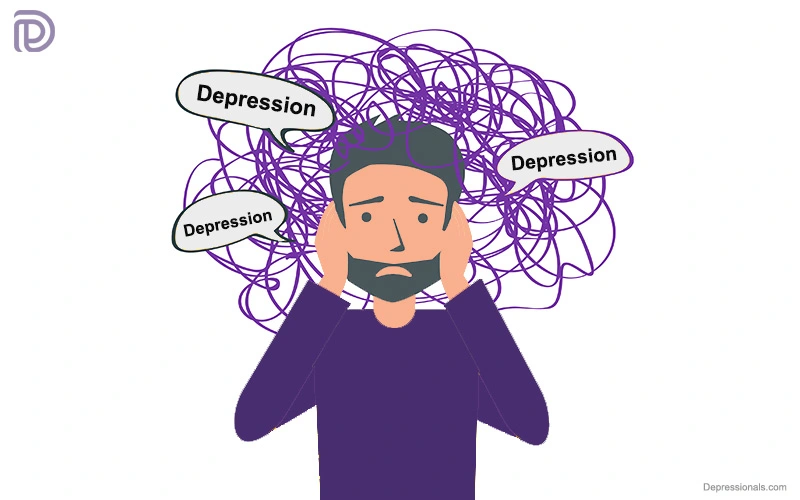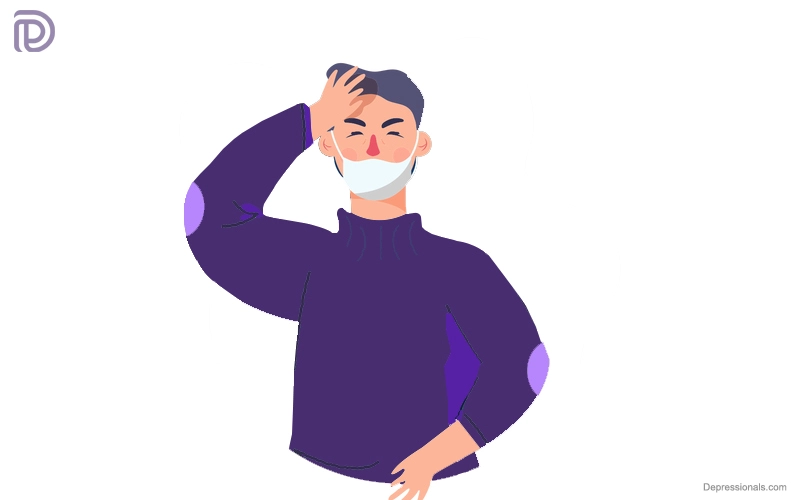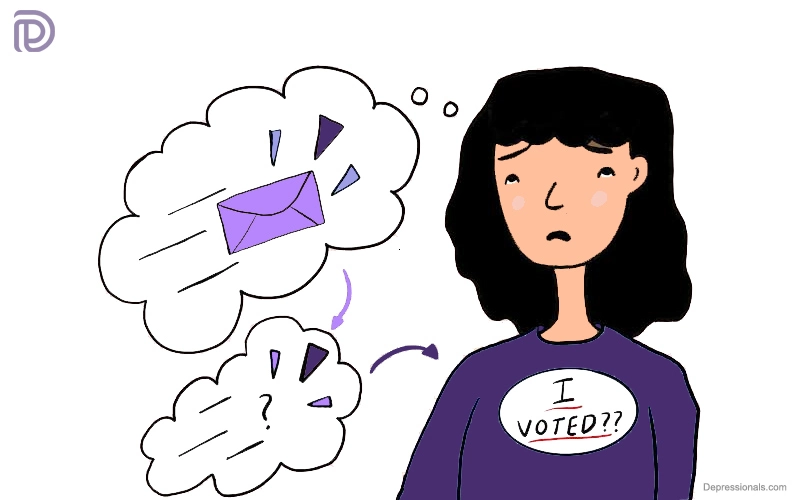Many symptoms of depression are brought about by the biology of depression, including sleep disruption, inability to experience pleasure, and feeling of guilt. An individual’s reaction to stressful events, whether they become depressed, and how they manifest the disorder depends on many factors. The factors include genetic traits, life experiences, temperament, personality traits, and social support.
However, an exact understanding of how biological changes cause depression remains elusive. Research into the biology of depression continues because of its complexity and its importance to human suffering.
Read: Difference Between Sadness and Depression
How does genetics affect depression?
It is considered that depression is inherited polygenetically, that is, several unknown genes contribute a small risk each in certain environmental conditions. Nevertheless, no genetic factor is sufficient to cause depression. An individual’s lifetime risk of depression increases by two or three times when they have at least one first-degree relative (parent, sibling) with depression.
The risk of major depression is affected by a variety of non-genetic factors, as well as inherited factors. There is a bit more complexity to the story, however, since certain nongenetic factors, including a variety of adverse childhood experiences, such as repeated abuse or neglect, can have long-term effects on genes (like those that activate the stress system) that can result in depression in later life.
Researchers believe the serotonin transporter gene (which is linked to serotonin production) has the most bearing on depression susceptibility – it may be able to moderate the impact of stressful life events. However, the evidence is mixed. There is more evidence that lifestyle and life experience factors play a significant role in the biology of depression.
Is it possible to modify depression genes?
The function and expression of many genes can be altered without altering the structure of the genes themselves, which is virtually impossible. The term epigenetic refers to these changes. Epigenetic changes can lead to depression as a result of experiences in life. Stress hormones can permanently reset the sensitivity of receptors in rat pups, for instance, if they are not properly cared for by their mothers. They grow up to exhibit depression-like behavior if their mothers do not lick and groom them.
However, it is also possible to reverse symptoms of depression through strategies that can influence epigenetic changes. Nutritional supplements, such as SAM-e, can enhance the activation and deactivation of genes by chemically enhancing their function in the body. This helps to alleviate depression symptoms in some cases.
Read: Work Depression
How does depression affect the brain?
Several factors contribute to depression onset or progression, including an overactive stress response system, shifts in brain activity of various neurochemicals, diminished nerve circuitry, disrupted nerve generation, interference in nerve cell energy use, infiltration of inflammatory substances, and disruption of the circadian clock in the brain. Each of these factors influences how depression manifests and how severe it is.
The Hippocampus (the seat of memory) and cortex (the thinking part of the brain) are two major brain regions that shrink. Several neuronal connections are reduced in size and number as well. The same study also showed that depression is linked to overactivity of the amygdala, which signals threat and produces negative emotions, as well as the hypothalamus, which coordinates the stress response.
Depression can lead to difficulty making decisions and a fog of cognition due to an inadequate response in the prefrontal cortex, which interprets and regulates emotional signals coming from the amygdala.
Neuroplasticity, a key component of learning and adaptation, maybe a feature unique to the human brain. The neuroplasticity of the hippocampus is impaired in depression. Additionally, reward centers shrink and stop responding to stimulation. Hormones that regulate appetite are changed, and as a result appetite changes.
Read: Depression in Children
What is the brain’s role in mood regulation?
The term mood refers to a sustained emotion that is more sustained than emotions. Emotion and mood are likely related through the amygdala, which is where emotions are encoded. However, it also involves the prefrontal cortex, which interacts with the amygdala via two-way circuits, helping it regulate its emotional response and influencing its general state of reactivity.
The moods are usually relatively stable under normal circumstances. Positive mood persists despite the amygdala and cortex being in close contact.
Circadian rhythms also influence mood because they regulate the timing of many physiological activities, particularly sleep-wake cycles. Depressive patients have abnormal patterns of numerous bodily functions, from temperature regulation to hormone production, so disturbances in biological rhythms are known to disrupt mood.
How does serotonin affect depression?
Many neurotransmitters in the brain are associated with depressive symptoms, including serotonin. According to this model, serotonin is involved in inhibiting pain, influencing the processing of emotions, and mediating many mental abilities that are critical for social interactions.
But it is also affected by stress-related hormones, such as cortisol, like the other neurotransmitters involved in depression. It disrupts the circuitry that regulates moral emotions, among other things, by causing a lack of serotonin. Researchers suspect that is why those suffering from depression feel a sense of guilt and excessive self-blame.
Read: Teen Depression
What is the role of dopamine in depression?
Several brain signaling chemicals are implicated in depression, including dopamine, a neurotransmitter involved with motivation and desire. It is characterized by two of depression’s most prominent symptoms-anhedonia and alteration of appetite.
How dopamine relays signals can be influenced by stress, which also alters the neurons’ excitability and activity. Researchers also found that areas of the brain that release dopamine are underactive when you’re depressed, like the nucleus accumbens.
The neurochemistry of depression
Talking to someone uses your lungs to push air through your larynx, your mouth to combine the waves of sound into words, and your brain to interpret the sound of your voice.
Communication between neurons occurs through the release of chemicals known as neurotransmitters into the gap between them. An excitation signal triggers the neuron to release some of these transmitters into the gap when it receives a signal from the excitation. An increase in neuronal activity occurs when neurotransmitters bind to receptors on the other side.
The biology of depression is affected by only a few neurotransmitters (that are known). First, there is norepinephrine, which is involved in mobilizing the body and mind.
Neurotransmitters serve their purpose at the synapse, and then they disappear. Reuptake occurs when a balloon is recycled, or breaking down occurs when enzymes break down a balloon, which is then flushed away in urine.
Researchers discovered that norepinephrine played a role in the biology of depression in the 1960s, leading to the development of the first antidepressant: MAOIs. The MAOIs reduce the breakdown of norepinephrine. This increases the duration of the norepinephrine signal at the synapse by prolonging the duration of its stay there. Depressive symptoms suddenly disappear.
Read: Situational Depression
What parts of the brain are involved in depression?
Depression is caused by several brain regions, such as the hippocampus (which is involved with memory and learning), and the suprachiasmatic nucleus (which regulates sleep and wakefulness). The amygdala flags emotion-related stimuli, and the prefrontal cortex regulates emotional reactivity, and controls attention, according to brain imaging studies, but the primary depression circuit is composed of the amygdala. In addition to these two-way connections, there is a two-way network of nerve fibers that enables them to analyze and interpret experience.
Depression is characterized by an overactive amygdala that continuously leaks emotions and a hypoactive PFC that can’t regulate the stream. Deficiencies in the PFC further dysregulate the amygdala, which produces more negative emotions because of feedback loops.
How does brain imaging help diagnose depression?
Static brain imaging can be performed on depressed patients to determine whether specific brain structures are larger or smaller than normal. CT scans and magnetic resonance imaging (MRI) use images of the brain to perform this task. A PET scan and fMRI examine the brain in action to determine whether and where there are problems with certain types of information that the brain processes.
FMRI studies usually involve depressed patients and normal controls performing a task in the scanner. An experimenter may ask the subject to view images with emotionally distressing content such as a picture that describes a disturbing situation to observe how the brain responds to negative stimuli.
Scanners can measure blood flow and metabolic activity in the brain by injecting substances into the bloodstream and measuring their concentrations. Hot spots and dead zones of activity in depressed patients and controls are compared to demonstrate areas of the brain undergoing dysfunction.
Read: Melancholic Depression
How does depression itself affect the brain?
Depressive episodes that last longer are more likely to recur. We are only now beginning to understand the biology of depression that affects the brain. Depression can progress into neurodegenerative disease without treatment.
Chronic stress, one of the causes of depression, releases hormones that lead to shrinkage of the hippocampus, a part of the brain that is vital to memory and learning. A sustained tendency to produce negatively coding emotions is created by significant changes in other brain areas, including the amygdala.
Depressive disorders, when left untreated, also alter the production of substances essential for regulating mitochondria, the energy factories in all cells, which is especially important for maintaining the proper functioning of the brain because it is such a metabolically active organ. Furthermore, depression alters brain areas that are involved in processing physical pain, and hyperactivity of those brain areas is related to the severity of depression.
The effects of long-term depression on the brain are similar to those of other neurodegenerative illnesses, such as Parkinson’s and Alzheimer’s. Inflammatory substances in the brain worsen brain function, affecting many brain regions and circuits in the brain.
How does talk therapy affect the brain?
Researchers have shown that cognitive behavioral therapy (CBT) produces long-lasting changes in patients with depression and other mental health conditions, particularly in emotion, cognition, behavior, and somatic symptoms. Researchers found that CBT changes brain connections, particularly in circuits that process emotions, using functional magnetic resonance imaging (fMRI).
According to the images, the amygdala of the brain is less responsive to emotions, while the prefrontal cortex, the brain’s thinking and executive control center, is more active, indicating a greater ability to control emotions, memories, and solutions. Cognitive changes assist in reducing negative emotions by enhancing the ability of individuals to cope with, and calmly manage, experiences and thoughts that cause them to become emotional.
Read: Economic Depression
How can you stimulate neuroplasticity?
The therapies available to treat depression promote the growth of new brain connections. The formation of new nerve cell connections is not affected by antidepressants. Researchers have discovered that neuroplasticity can be induced in multiple ways.
Aerobic exercise is one of the best ways. It can take any intensity to have an impact. Any form of physical activity stimulates the production of neurotrophic factors, your body’s natural means of stimulating your brain to grow and recover.
Researchers have also found that diet, particularly intermittent fasting, also increases the level of brain-derived neurotrophic factor, one of the most well-studied agents to stimulate cell growth in the nervous system. An intermittent fast is neuroprotective, protecting brain cells from the degeneration associated with aging.






I was reading some of your content on this website and I conceive this internet site is really informative ! Keep on putting up.
Nice post. I was checking constantly this blog and I’m impressed! Extremely useful info specially the last part I care for such information a lot. I was seeking this certain info for a long time. Thank you and good luck.
I like the helpful information you provide in your articles. I’ll bookmark your blog and check again here frequently. I am quite sure I’ll learn a lot of new stuff right here! Best of luck for the next!